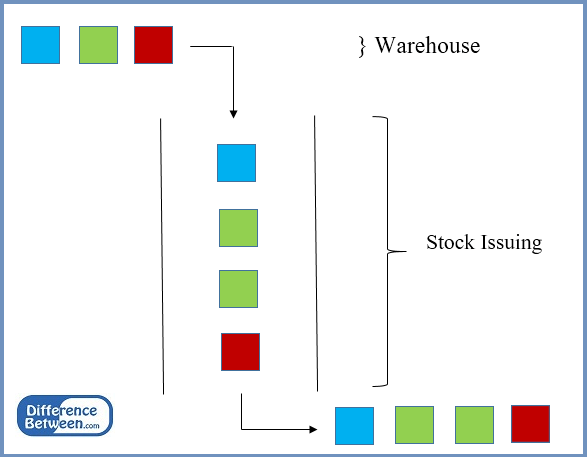Difference Between FIFO and Weighted Average
Key Difference – FIFO vs Weighted Average
FIFO (First in First Out) and weighted average method are inventory valuation methods. Inventory is one of the most vital current assets and some companies operate with significant amounts of inventories. Proper valuation of inventory is essential to show effective results in financial statements. The key difference between FIFO and weighted average is that FIFO is an inventory valuation method where the first purchased goods are sold first whereas weighted average method uses the average inventory levels to calculate inventory value.
CONTENTS
1. Overview and Key Difference
2. What is FIFO
3. What is Weighted Average
4. Side by Side Comparison – FIFO vs Weighted Average
5. Summary
What is FIFO?
FIFO operates under the principle which states that first purchased goods are the ones that should be sold first. In most companies, this is very similar to the actual flow of goods; thus, FIFO is considered to be the most theoretically accurate inventory valuation system among others.
E.g. ABC Ltd. is a bookstore that sells study material (books) to universities. Consider the following purchases and related prices for the month of March.
| Date | Quantity (books) | Price (per book) |
| 02nd March | 1000 | $ 250 |
| 15th March | 1500 | $ 300 |
| 25th March | 1850 | $ 315 |
From the total quantity of 4350, assume that 3500 is sold and the sale will be done as follows.
1000 books @ $ 250 = $ 250,000
1500 books @ $ 300 = $ 450,000
500 @ $315 = $ 157,500
Remaining inventory (1350 @ $ 315) = $ 425,250
FIFO is the preferred method by many organizations since the company is not likely to be left with outdated inventory under this method. Companies that use FIFO will constantly have updated market prices reflected in their inventory. The drawback of this method is that this is inconsistent with the prices quoted for customers.

Figure 01: Stock Issuance in FIFO
What is Weighted Average?
This method values inventory by dividing the cost of the goods available for sale by the number of goods, thus calculating an average cost. This helps to arrive at a value that does not represent oldest or latest units. Considering the same example,
E.g. Total number of books,
1000 books @ $ 250 = $ 250,000
1500 books @ $ 200 = $ 300,000
1850 books @ $ 315 = $ 582,750
Cost of a book ($ 1,132,750/4350) = $ 260.40 per book
Cost of goods sold (3500* $260.40) = $ 911,400
Remaining inventory (1350* 260.40) = $ 351,540
The main advantage of weighted average method is that it evens out effects of widely varying prices due to the average use of price. Further, this is a convenient and simple method of inventory valuation. However, the issue of inventory may not reflect the prevailing economic values. Another disadvantage of this method is that when the average value of inventory is divided by the number of units, this often results in an amount with decimal points that has to be rounded up/down to the nearest whole number. Thus, this does not provide a perfectly accurate valuation.
What is the difference between FIFO and Weighted Average?
FIFO vs Weighted Average | |
| FIFO is an inventory valuation method where the first purchased goods are sold first. | Weighted average method uses the average inventory levels to calculate inventory value. |
| Usage | |
| FIFO is the most commonly used inventory valuation method. | Usage of weighted average method is less compared to FIFO. |
| Method | |
| Inventory will be issued from the oldest available batch. | Inventory will be averaged out to arrive at a price. |
Summary – FIFO vs Weighted Average
While both FIFO and weighted average are popular inventory valuation methods, companies can decide which method to use based on their discretion. The difference between the two depends on the way the inventory is issued; one method sells the goods purchased first (FIFO) and the other calculates the average price for the total inventory (weighted average). The inventory valuation records are internal for the company while its effects will be reflected in the income statement in the cost of goods sold section.
References:
1.Morah, Chizoba. “What’s the difference between weighted average accounting and FIFO/LILO accounting methods?” Investopedia. N.p., 30 Apr. 2009. Web. 23 Mar. 2017.
2.”Advantages & Disadvantages of Average Cost Method.” Chron.com. Chron.com, 29 Mar. 2013. Web. 23 Mar. 2017.
3.”Weighted Average Method.” AccountingTools. N.p., n.d. Web. 23 Mar. 2017.
4.”FIFO vs LIFO: The Disadvantages and Advantages to Inventory Valuation.” Udemy Blog. N.p., n.d. Web. 23 Mar. 2017.
ncG1vNJzZmivp6x7pbXFn5yrnZ6YsqOx07CcnqZemLyue8OinZ%2Bdopq7pLGMm5ytr5Wau26yyJ%2BmZpmemXq3v4ywnKKfmKmypXnAr5yrmZeafA%3D%3D